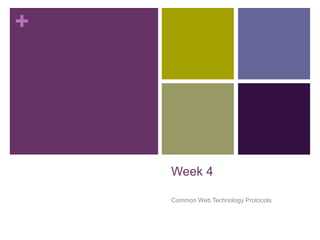Report
Share

Recommended
Recommended
More Related Content
What's hot
What's hot (20)
Similar to Protocols
Similar to Protocols (20)
TCP - TCP breaks data into manageable packets and tracks information.pdf

TCP - TCP breaks data into manageable packets and tracks information.pdf
Networking:) Based on Ethical Hacking And Cyber Security

Networking:) Based on Ethical Hacking And Cyber Security
TCP RFC 793 TCPIP (Transmission Control ProtocolInternet Proto.pdf

TCP RFC 793 TCPIP (Transmission Control ProtocolInternet Proto.pdf
INTRODUCTION TO INTERNET PROTOCOL BY SAIKIRAN PANJALA

INTRODUCTION TO INTERNET PROTOCOL BY SAIKIRAN PANJALA
Application layer and protocols of application layer

Application layer and protocols of application layer
network protocol | Networking by Nitasha Chaturvedi

network protocol | Networking by Nitasha Chaturvedi
More from Kopi Maheswaran
More from Kopi Maheswaran (20)
Rhythm, framing, transparency and time & motion

Rhythm, framing, transparency and time & motion
Recently uploaded
Recently uploaded (20)
Beyond the EU: DORA and NIS 2 Directive's Global Impact

Beyond the EU: DORA and NIS 2 Directive's Global Impact
Ecosystem Interactions Class Discussion Presentation in Blue Green Lined Styl...

Ecosystem Interactions Class Discussion Presentation in Blue Green Lined Styl...
Kisan Call Centre - To harness potential of ICT in Agriculture by answer farm...

Kisan Call Centre - To harness potential of ICT in Agriculture by answer farm...
Measures of Central Tendency: Mean, Median and Mode

Measures of Central Tendency: Mean, Median and Mode
Disha NEET Physics Guide for classes 11 and 12.pdf

Disha NEET Physics Guide for classes 11 and 12.pdf
Protocols
- 1. + Week 4 Common Web Technology Protocols
- 2. + PROTOCOLS A set of rules governing the exchange or transmission of data between devices. Protocols are usually assigned to specific PORTs on a computer. A port is like an extension on a phone system.
- 3. + IP, TCP and UDP IP – Internet Protocol TCP - Transmission Control Protocol UDP – User Datagram Protocol
- 4. + TCP and UDP These two protocols enable communication between all computers on the internet. TCP is the main protocol of the internet. It needs to establish a connection between the two computers before it will send information UDP does not require the other computer to acknowledge that it is connected before sending. It just sends. DNS usually uses UDP
- 5. + Common Protocols HTTP – Hyper Text Transfer Protocol This is the main protocol used well surfing the web to view HTML (Hyper Text Markup Language) documents. Data is sent in the open (not encrypted) FTP – File Transfer Protocol FTP was the initial protocol for transferring files from computer to computer. User credentials and data are sent in the open (not encrypted) Telnet – Teletype Network Text base commands / communication between computers. User credentials and data are sent in the open (not encrypted)
- 6. + Common Protocols HTTPs – Hyper Text Transfer Protocol Secure This is the main protocol used well surfing the web to view HTML (Hyper Text Markup Language) documents. Info is encrypted! FTPs – File Transfer Protocol Secure Info is encrypted! SFTP – Secure File Transfer Protocol Uses SSH Info is encrypted! SSH – Secure Shell A secure version of Telnet Info is encrypted! SCP – Secure Copy Protocol Info is encrypted! Subset of SSH
- 7. + Mail Protocols POP3 – Post Office Protocol v3 Used for coping/retreiving messages from server to computer SMTP– Simple Mail Transfer Protocol Used for sending messages to a server(s) IMAP– Internet Message Access Protocol Used to view/manipulate messages on server
- 8. + Other Protocols DHCP– Dynamic Host Configuration Protocol Used for dynamically assigning IP addresses to computers in a private network. DNS– Domain Name System Converts or stores IP to Domain Name references
- 9. + Protocols - PORTS Protocol PORT ftp 21 SSH/scp/FTPs 22 telnet 23 pop3 110 smtp 25 imap 143 http 80 https 443 dns 53
- 10. + Other URL– Uniform Resource Locator Used to specify the address of almost all network resources. SSL – Secure Socket Layer Additional layer to provide common cryptographic protocol to other protocols. TLS – Transport Layer Security– is basically v3 of SSL
- 11. + Common bash commands telnet (telnet dca.durhamcollege.ca 80) ls : list the content s of the directory (ls –l, ls –la) cd : change directory (cd web_design , cd ../) pwd : print working directory (pwd) ssh : secure shell (ssh –l gubalaray dca.durhamcollege.ca) mkdir : make directory (mkdir web_design) quota –s : list your disk usage on the server man : display manual pages (man ls) vi : (vi hello.txt)